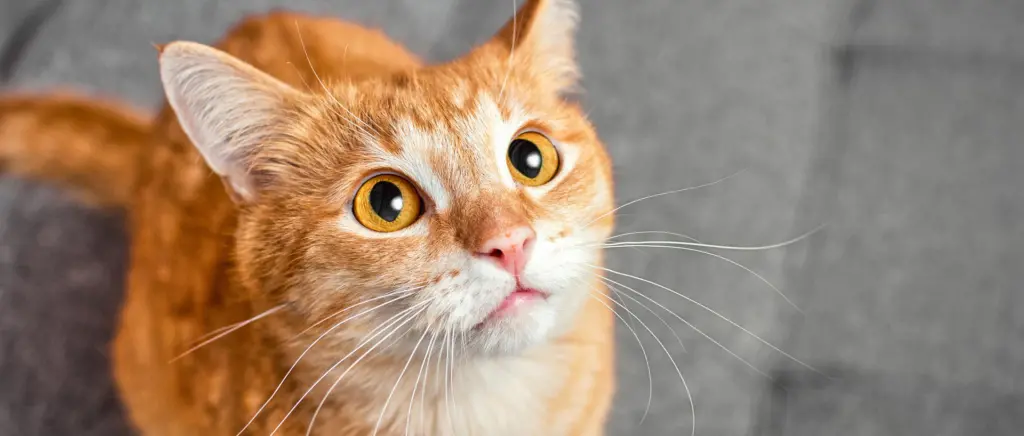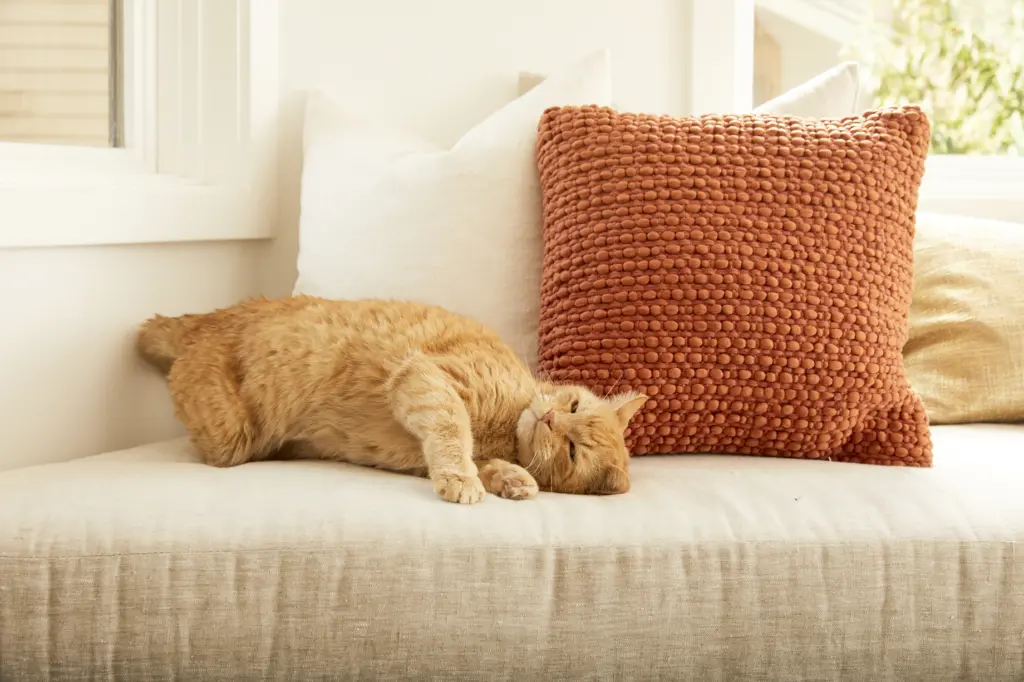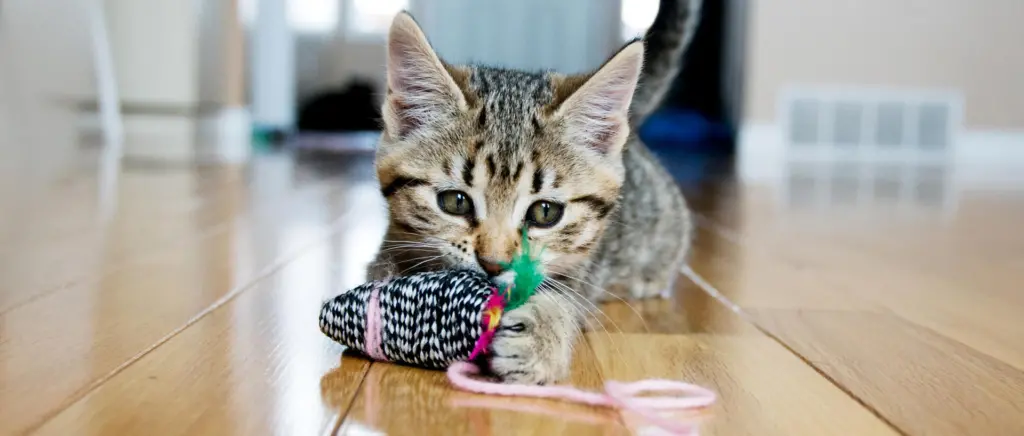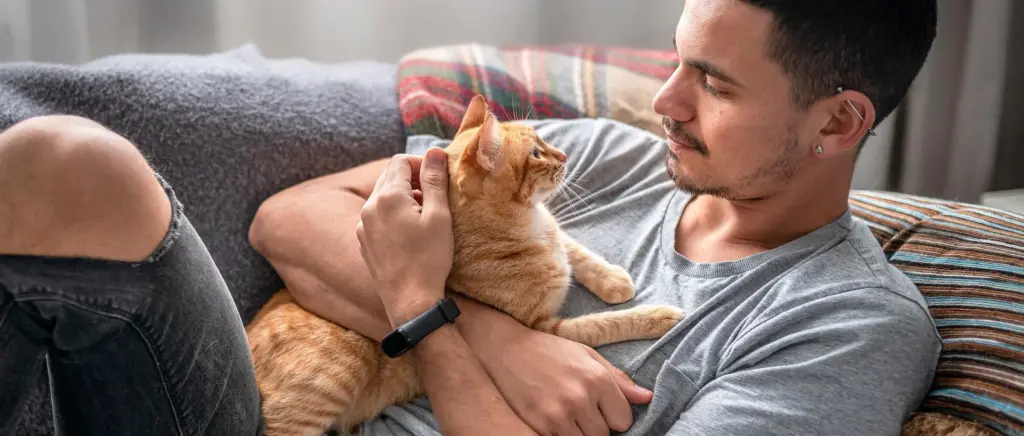
Good Food: Answers on Cat Nutrition & Feeding
Get guidance to help you compare the different types of cat food, plus advice on when, where and how to feed your cat.
The main difference between wet and dry cat food is the moisture content. Increased moisture or “water” content could be a benefit if your cat has trouble staying hydrated.
Wet food also tends to be denser in certain nutrients, including protein and fat — although your cat can get all the nutrients he or she needs from a diet of either wet or dry food, or a combination of both.
Dry food may be more convenient for cat owners, and the crunchy texture of the kibble can help clean your cat’s teeth to help support healthy teeth and gums.
If a food offers “complete and balanced nutrition for adult cats,” that means it contains the right amount of all the nutrients most adult cats need. You may also see products labeled as “100% nutritionally complete for adult cats,” which means the same thing. In other words, if you fed your adult cat the proper amount of that food and nothing else, your cat wouldn’t miss out on any vital nutrients or have too much of any nutrients.
If you have a kitten, or if your cat is pregnant or lactating, he or she needs some additional nutrients. In that case, look for a formula that offers complete and balanced nutrition for all life stages, including pregnant or nursing cats.
Complete cat nutrition includes a wide range of nutrients, which can be provided through various combinations of ingredients.
For starters, all cats need the following nutrients in one form or another:
- Amino acids (which make up protein, listed on cat food packages as “crude protein”)
- Arginine
- Histidine
- Isoleucine
- Leucine
- Lysine
- Methionine + cystine
- Methionine
- Phenylalanine + tyrosine
- Phenylalanine
- Threonine
- Tryptophan
- Valine
- Fatty acids (listed on cat food packages as “crude fat”)
- Linoleic acid
- Arachidonic acid
- Omega-3 fatty acids
- Minerals
- Calcium
- Phosphorus
- Potassium
- Sodium
- Chloride
- Magnesium
- Iron
- Copper
- Manganese
- Zinc
- Iodine
- Selenium (sometimes in the form of sodium selenite)
- Vitamins & other nutrients
- Vitamin A
- Vitamin D
- Vitamin E
- Vitamin K (only required in high-fish diets)
- Thiamine (vitamin B1)
- Riboflavin (vitamin B2)
- Pantothenic acid (vitamin B5)
- Niacin (vitamin B3)
- Pyridoxine (vitamin B6)
- Folic acid (vitamin B9)
- Biotin (vitamin B7)
- Vitamin B12
- Choline
- Taurine
Kittens and pregnant or lactating cats need different levels of the above nutrients, as well as the following additional nutrients, which should be included in any formula labeled “for all life stages”:
- Additional fatty acids
- Alpha-linolenic acid
- Eicosapentaenoic acid + docosahexaenoic acid (EPA + DHA)
Not at all. In fact, synthetic nutrients can not only be just as good for your cat as their natural counterparts; they’re often more shelf stable. In other words, many natural nutrients degrade quickly and, depending on how the food is prepared and stored, may have already disappeared from your cat’s food by the time you serve it. Therefore, the food needs to include synthetic versions of those nutrients to help avoid a nutrient deficiency.
The term “by-products” might sound unappealing to humans, but it refers to parts of an animal that are highly nutritious, such as organ meats like the liver, kidneys and lungs. While humans in our culture may not find these organs appetizing, they’re a valuable part of a feline’s natural diet.
Place your cat’s bowl in a clean, quiet place where there’s not a lot of foot traffic. If your cat is skittish, you may also want to avoid placing the bowl right up against a wall. That way, your cat can look at you while he or she eats, which may help him or her feel more secure. Also consider the size of your cat’s bowl. Make sure the bowl doesn’t inhibit his or her whiskers — some cats don’t like them touching the bowl.
Cow milk isn’t a natural part of cat nutrition, even for kittens. Young kittens should be given kitten milk replacement rather than cow milk. Unless your adult cat has been drinking milk consistently since kittenhood, he or she probably has become lactose intolerant. So it’s usually best not to give adult cats a significant amount of milk, no matter what kind. The consequences may make your cat uncomfortable, and they probably won’t be so pleasant for you either.
Cat nutrition and dog nutrition are very different, so dog food won’t work as a substitute for cat food.
One reason is that nutritional requirements for cats are not the same as those for dogs. Cats need certain nutrients that dogs don’t, and different levels of the nutrients dogs do need. There are also certain ingredients in some dog food that may not be ideal for cats to ingest.
In short, no; cats aren’t built for the vegetarian lifestyle. Cats are what’s called “obligate carnivores” because some of the nutrients they need can only be sourced from other animals.
Feeding instructions on 9Lives cat food packaging and product pages will give you a place to start, but exactly when you should feed your feline friend depends partly on your cat’s preferences. Some cats prefer to eat in one or two sittings a day, and others prefer to graze on kibble throughout the day.
If you serve dry food, it’s fine to serve a day’s worth at once and leave it out for grazing. If you serve wet food, though, it shouldn’t sit out. Throw out whatever your cat doesn’t finish within a few minutes or so of serving it, and always use a fresh bowl or plate at every feeding.
The recommended amounts to feed daily are based on the average cat population for an entire day’s worth of food. Your cat may have individual needs and may need more or less, so adjust accordingly.
For cats that may tend to overeat, it’s important not to “free feed.” (“Free feeding” basically means filling up a bowl and letting your cat eat as he/she pleases.) We recommend splitting up your cat’s daily food allowance into two or three servings a day.
If your cat tends to eat too fast, especially if it causes him or her to get sick, a puzzle feeder can help ration out food at a good pace. That way, your cat won’t be able to rush and will be more likely to notice when he or she is full.
Feel free to treat your cat daily, just not too much. Cat treats should make up no more than 10% of your cat’s daily diet. And whenever you do treat, make sure to adjust your cat’s main meals so that he or she isn’t getting extra calories overall.
It’s always best to check with your vet for an underlying health issue that may be affecting your cat’s appetite. However, if nothing is physically wrong with your cat, it’s probably a preference issue.
Sometimes, cats are picky. (Just ask our charmingly choosy spokes-cat.) They may even get bored of a food they previously liked. 9Lives foods offer a variety of flavors and textures to help you mix things up and recapture your cat’s interest.
You could also try moving your cat’s bowl or dish to someplace more approachable in the mind of a feline. Look for somewhere quiet and out-of-the-way, and/or where your cat can more easily see you while he or she eats.
Bonus tip: A toy in your cat’s food bowl may also help keep his or her interest and make eating a fun, entertaining activity.
Good Health: Addressing Common Cat Health Issues
Cat health can be confusing because a cat’s biology is so different from a human’s. When in doubt, it’s best to ask your vet. Meanwhile, here are answers to a few common cat health questions.
All 9Lives cat food varieties are made to help support a wide range of cat health benefits. Many adult cats get everything they need from 9Lives® Daily Essentials kibble. Other 9Lives varieties were specially created to help address specific needs.
- To help maintain urinary tract health – Urinary tract issues are a widespread problem among cats. 9Lives® PlusCare® is for cats with urinary tract issues by helping to reduce urinary pH.
- To help support strong muscles – 9Lives® ProteinPlus® provides the optimal balance of high-quality protein and vitamins to help support lean muscles and provide energy.
- To help support indoor cats’ specific needs – 9Lives® Indoor Complete delivers all the nutrients your adult cat needs to thrive indoors while helping to support a healthy weight and metabolism. It also includes plenty of natural fiber to help support healthy digestion.
- To help support healthy teeth and gums – The crunchy texture of 9Lives dry cat food can help scrape away plaque and tartar as your cat chews, to help support healthy teeth and healthy gums.
- To help support a healthy heart and clear vision – Your cat’s eye and heart health depend partly on taurine, a vital nutrient that cats can’t produce on their own and therefore need to get from their food. A taurine deficiency can lead to a weakened heart muscle and damage to the retina, which can ultimately cause heart failure and blindness. Each 9Lives cat food variety includes the proper amount of taurine your cat needs to help support heart health and visual clarity.
Even a healthy cat should visit a veterinarian twice a year for check-ups and any recommended vaccinations or booster shots. But if your cat shows signs of possible health issues, don’t wait. Call your vet right away.
If your cat hates going to the vet, you’re not alone. Today, you may be able to find convenient solutions, like in-home vet visits or even telemedicine, for certain types of appointments.
But the ideal solution would be to get your cat comfortable with a crate or carrier for easier transport. Try the following steps:
- Place a large carrier in a private area with the door open. Put a litterbox inside and a towel in front.
- After your cat has adjusted to using the litter box inside the crate, add a carrier cup. Put a few 9Lives treats in the cup and leave the door open as your cat eats them.
- The next time your cat goes in to use the litter box, add a few more 9Lives treats. Shut the door briefly, just until your cat has finished the treats.
- Repeat the process, gradually extending the time you leave the door closed.
Eventually, your kitty will come to see the carrier as a “pawsitive” experience and will happily get inside when it’s time to go somewhere.
Both indoor and outdoor cats should be vaccinated and protected against parasites and should visit the veterinarian regularly. Both indoor and outdoor cats should also be microchipped so that they can be returned home if they sneak out, escape or become lost and are found by another human.
The biggest difference in indoor vs. outdoor cat health needs is due to differing activity levels. Indoor cats are generally less active than outdoor cats, so it’s especially important to watch their body weight. Be extra careful to avoid overfeeding in order to help prevent obesity and related health issues.
A Good Home: Cat Adoption & Creating a Comfort Zone for Cats
Living with a cat can be quite the adventure. Sometimes it’s hard to know what your cat needs or wants. These cat care tips can help you create a happy home for all.
Congrats! Cat adoption is a wonderful choice, and you have so much to look forward to with your new feline family member.
To help your cat adjust to his or her new home, start slow. Let your cat explore a safe space away from any commotion, like a small bedroom or bathroom. Once your cat seems relaxed and confident in this room, open the door to encourage exploration, but keep that space available for him or her as a retreat.
Try getting down to your cat’s level to interact. Sit on the floor and use cat toys to attract interest. Allow your kitty to come up and greet you on his or her own terms.
Most importantly, be patient. Some cats are outgoing, and some are more timid. Remember to let your cat adapt to the household at his or her own pace.
Taking care to introduce animals properly can go a long way in ensuring your cat adoption goes smoothly. The first step is to give it time; wait two to four weeks before introducing your new cat to other pets.
When the time comes, you may want to make your other pets smell more appealing to your new cat using a small amount of a pungent, cat-approved substance. You could use sardine water, for example. You may also want to use a pheromone diffuser to help your cat feel calm and safe.
This is a great question and VERY important to keep in mind! Many plants that are harmless to humans are extremely toxic and possibly fatal to cats, even if cats don’t actually eat them. For example, lilies can cause acute kidney failure in cats — just from contact with the pollen. Other common plants that are hazardous to cats include onions, garlic and more. Be sure to check the full list of plants that are toxic to cats.
Cats were originally desert animals, so they don’t need quite as much water as you might expect. That said, they do need to drink water regularly. If they tend not to, dehydration is a legitimate concern.
Try putting out a water bowl that’s wide enough for your cat to drink out of without his or her whiskers hitting the sides. If your cat prefers running water, a cat water fountain may do the trick. Either way, always make sure your cat has access to fresh water. You could also include wet food in your cat’s diet to subtly increase moisture intake.
Cats tend to be nocturnal, so if you want them to sleep more at night, they’ll need to burn off energy before bedtime. Read: Make sure they get plenty of playtime! One fun and easy trick for evening entertainment is to tie a string around your waist and tie a cat toy on the end that dangles on the floor. Anytime you move around, the toy will too, giving your cat something fun to chase.
To keep things interesting, rotate which toys you leave out for your cat. Putting some toys away for a few days will make them new and exciting when you reveal them again. You can also find toys that use a timer to engage your cat throughout the day. For example, some toys shoot out a toy mouse every few hours. Look around at your favorite pet stores or online retailers to see what your cat might like. Also be sure to keep a scratching board or post available.
If your pup tends to hog your cat’s toys, consider designating a dog-free room for your cat to play in.
If your cat tends to go for the dog’s things, consider using catnip toys or putting catnip spray on existing cat toys. This will attract your cat’s attention to his or her own toys without attracting your dog in the same way.
While cats do self-groom to a degree, proper cat care still requires helping them out with a few things. You’ll want to regularly brush your cat and trim his or her nails. Some cats may need you to clean their ears if they have a history of ear infections. Your cat will also occasionally need a bath. For cats who don’t like water, you can try waterless shampoo, but it may be easiest and most effective to leave bathing to a groomer.
Some cats may need sedation if a bath or shaving is necessary. If this is a service your cat needs, make sure you work with a groomer that has a veterinarian on site.
Start by taking note of the types of things your cat likes to scratch. Are they soft or hard? Vertical or horizontal?
Then, cover the items you want to protect. Coverings like bubble wrap or double-sided tape tend to deter cats from scratching. Or you could try simply covering at-risk surfaces with something of the opposite texture.
Finally, provide something your cat is meant to scratch, like a dedicated cat scratching post or board, with the type of texture and orientation your cat prefers. When your cat scratches that item, be sure to reward him or her with a 9Lives treat.
One great thing about cats is that they’re easy to house train and tend to know what to do when they see a litter box. All you have to do is find a box and litter they’re comfortable with, put it in a good location and keep it clean. There are many types of litter and litter boxes out there, and some cats will prefer certain types.
It’s best to provide at least one litter box per cat, per floor of your home. Place the litter box in a low-traffic area where your cat feels safe and comfortable, and where the box is easy to access. If your cat seems OK with the litter box’s location, keep it there long-term to avoid confusing your kitty.



